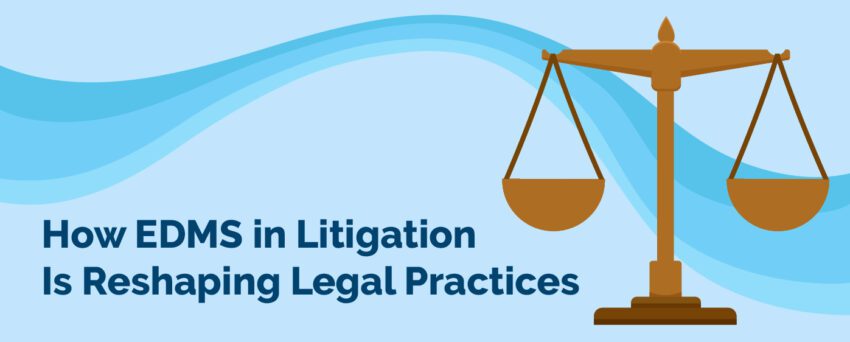03Jun 2024
Electronic document management software (EDMS) has become a game-changer in litigation support for legal practices. Managing documents is both a critical and challenging task in the fast-paced legal landscape. With the increasing number of cases and clients, lawyers and legal professionals often find themselves needing help to keep up with the large volume of documents waiting to be organized, stored, and accessed daily.
In the past, attorneys relied on physical paper-based systems for managing their legal documents. This has proven to be not only time-consuming but also prone to human error and security threats. The growing demand for more efficient and secure document management solutions is still a pivotal topic for legal professionals to discuss.

Key Advantages of Using Document Management Software in Legal Practices
Document management software allows law firms to scan, store, manage, and access all types of digital documents in one centralized location. It also offers a variety of features such as document version control, secure sharing and collaboration, automated workflows, and advanced search capabilities.
Electronic document management systems are designed to streamline the document management process and improve productivity for legal professionals. It eliminates the need for physical storage space, reduces the risk of human error, and ensures documents are easily accessible when needed.
1. Improved Organization
Legal practices can more efficiently and systematically organize their documents. Documents can be categorized to make retrieving specific files quick and easy, and they can be organized by case type, client name, and date.
2. Avoided Delays
When relying heavily on paper-based systems, traditional law practices face numerous obstacles that drain resources and hinder productivity and client services. EDMS is designed to address these common hurdles, including:
- Storage Limitations – Physical documents require substantial space, often leading to cluttered offices and offsite storage solutions.
- Security Inefficiencies – Finding specific documents within a vast archive can be time-consuming and error-prone.
- Security Risks – Paper documents are susceptible to theft, damage, and loss.
- Compliance Challenges – Ensuring all documents meet compliance and regulatory mandates is a continuous, labor-intensive process.
4 Benefits of EDMS Implementation in Legal Practices
Implementing an EDMS into your legal practice can benefit your law firm in several ways. Four primary benefits include:
1. Improved Efficiency
Legal professionals can significantly reduce the time spent on document-related tasks. EDMS options like advanced search and centralized storage of documents eliminate the need for manual filing and retrieval. As a result, attorneys can dedicate more time to their core responsibilities, ultimately improving client satisfaction and firm productivity.
2. Enhanced Security
Client confidentiality is of utmost importance in the legal industry, as legal documents often contain sensitive information that requires robust security measures. Electronic scanning, management, and storage solutions aid in risk management and regulatory compliance by ensuring sensitive records remain protected against unauthorized access. With features like encrypted storage, access control, and audit trails, law firms can have peace of mind knowing that their documents are secure.
3. Cost Savings
Implementing legal document storage and management solutions can lead to significant cost savings for a legal practice. With reduced paper usage and streamlined workflows, law firms can reduce costs on printing, storage, and administrative expenses. Eliminating physical file storage also frees up valuable office space that can be used for other purposes.
4. Compliance Management
Maintaining compliance with legal regulations is paramount. EDMS helps law firms adhere to these requirements by providing features like document retention schedules and automated compliance checks. These tools ensure all documents are appropriately archived and disposed of according to legal mandates.
8 Document Management System Features for Litigation
The best document management software systems for litigation offer a digital solution that enables easy storage, retrieval, management, and tracking of electronic documents. It offers a centralized repository for all types of legal files, including documents, images, videos, and emails. EDMS is designed to streamline document-related processes while promoting compliance, security, and collaboration.
Eight key features of a document management system include:
- Document Capture – Automated scanning and indexing capabilities allow for quick conversion of physical documents into digital files.
- Indexing and Metadata Management – Documents can be indexed based on relevant criteria such as case number, client name, or date. This makes it easier to retrieve specific files using search functions.
- Version Control – Multiple users can access and work on the same document simultaneously without worrying about version control issues.
- Security Controls – Robust security controls ensure your confidential documents and records are kept safe against any human error and cybersecurity threats.
- Centralized Storage – All documents are stored in a single, easily accessible repository.
- Advanced Search Capabilities – Use metadata, keywords, and full-text search to quickly locate documents.
- Audit Trails – Keep detailed logs of document access and modifications for compliance purposes.
- Collaboration Tools – Enable real-time collaboration among team members, regardless of their physical location.
These features streamline collective document management, making day-to-day operations more efficient and secure.
8 EDMS Trends Shaping the Future of Legal Document Management
Advancements in EDMS continue to play a crucial role in shaping the future of legal document management. It will streamline processes, increase efficiency, improve accessibility and collaboration, and enhance data security for law firms worldwide.
As technology continues to evolve, we can only expect a promising future with further innovation and improvements in electronic document management solutions.
Several EDMS trends are expected to revolutionize legal document management:
1. Artificial Intelligence (AI)
 With AI-powered EDMS, law firms can expect increased efficiency and accuracy in document management. AI will enhance document search capabilities, automate routine tasks, and provide predictive analytics — making document management even more efficient and accurate.
With AI-powered EDMS, law firms can expect increased efficiency and accuracy in document management. AI will enhance document search capabilities, automate routine tasks, and provide predictive analytics — making document management even more efficient and accurate.
Features such as optical character recognition (OCR) and natural language processing (NLP) can help automate tasks like data extraction and verification.
2. Cloud-Based Solutions
 The demand for cloud-based solutions is increasing as cloud storage offers greater flexibility, scalability, and cost-efficiency.
The demand for cloud-based solutions is increasing as cloud storage offers greater flexibility, scalability, and cost-efficiency.
3. Integration With More Software
 As technology becomes more interconnected, integration capabilities will play a crucial role in selecting an EDMS. Expect to see more seamless integration between electronic document management software and other software used in the legal industry.
As technology becomes more interconnected, integration capabilities will play a crucial role in selecting an EDMS. Expect to see more seamless integration between electronic document management software and other software used in the legal industry.
4. Mobile Accessibility
 Mobile-friendly EDMS solutions will allow legal professionals to access documents from anywhere, at any time. In today’s digital world, professionals are increasingly working on the go and mobile accessibility has become a necessity for business operations. EDMS providers must cater to this need by offering mobile-friendly versions of their software.
Mobile-friendly EDMS solutions will allow legal professionals to access documents from anywhere, at any time. In today’s digital world, professionals are increasingly working on the go and mobile accessibility has become a necessity for business operations. EDMS providers must cater to this need by offering mobile-friendly versions of their software.
5. Cybersecurity
 As cyber threats become more sophisticated, EDMS providers must prioritize cybersecurity to protect sensitive legal information. Expect to see increased security measures and compliance standards in the future.
As cyber threats become more sophisticated, EDMS providers must prioritize cybersecurity to protect sensitive legal information. Expect to see increased security measures and compliance standards in the future.
6. Blockchain Technology
 Blockchain can provide an immutable ledger for document transactions, enhancing security and authenticity. As the legal industry becomes more digitized, expect to see an increase in the use of blockchain technology for document management. This technology can streamline the process of document sharing and collaboration between parties.
Blockchain can provide an immutable ledger for document transactions, enhancing security and authenticity. As the legal industry becomes more digitized, expect to see an increase in the use of blockchain technology for document management. This technology can streamline the process of document sharing and collaboration between parties.
7. Data Analytics
 With the increasing amount of digital documents being created, data analytics will play a crucial role in identifying patterns and trends within legal documents. This information can be used to improve processes, make better decisions, and predict outcomes for cases.
With the increasing amount of digital documents being created, data analytics will play a crucial role in identifying patterns and trends within legal documents. This information can be used to improve processes, make better decisions, and predict outcomes for cases.
8. Collaboration Tools
 Collaboration is an essential aspect of legal work, and EDMS providers are increasingly offering tools that promote seamless collaboration between colleagues and clients. These tools may include real-time document editing, task assignment and tracking, and comment and feedback features.
Collaboration is an essential aspect of legal work, and EDMS providers are increasingly offering tools that promote seamless collaboration between colleagues and clients. These tools may include real-time document editing, task assignment and tracking, and comment and feedback features.
Implementing a document management tool is crucial for modern law firms looking to stay competitive in today’s digital landscape. By staying ahead of these trends, law firms can ensure they remain innovative and efficient in an increasingly digital world.
Choosing the Right EDMS for Your Legal Practice
Selecting the right EDMS for your legal practice involves consideration of several factors. These include:
-
- Scalability: Ensure the software can grow with your law practice, accommodating an increasing volume of documents and users. This is especially crucial for firms with expansion plans.
- Integrations and Compatibility: Look for an electronic document management system that seamlessly integrates with your existing legal practice management software.
- Customization Options: Consider EDMS with customization tools to suit your specific document management needs.
- Security Features: Evaluate the available security features of different electronic document management systems and select one that aligns with your law firm’s security needs.
- User-Friendliness: A user-friendly interface is crucial for quick adoption across your firm. User adoption is key to the successful implementation and utilization of an EDMS.
- Support and Training: Comprehensive support and training services are essential for smooth implementation and ongoing use.
- Cost: Evaluate the total cost of ownership, including initial setup fees, ongoing subscription costs, and potential hidden expenses.
- Scalability: Ensure the software can grow with your law practice, accommodating an increasing volume of documents and users. This is especially crucial for firms with expansion plans.

Integrating Electronic Document Management Software in Litigation
 The integration of electronic document management software in litigation is a necessity for modern legal practices. By embracing EDMS, law firms can overcome traditional document management challenges, enhance security, meet compliance standards, and ultimately deliver better client service.
The integration of electronic document management software in litigation is a necessity for modern legal practices. By embracing EDMS, law firms can overcome traditional document management challenges, enhance security, meet compliance standards, and ultimately deliver better client service.
If you’re ready to transform your legal practice, consider integrating EDMS into your operations with DOCUdavit. The benefits are clear, and the future is digital. Reach out to an expert today to explore how document management software can specifically benefit your law firm.

